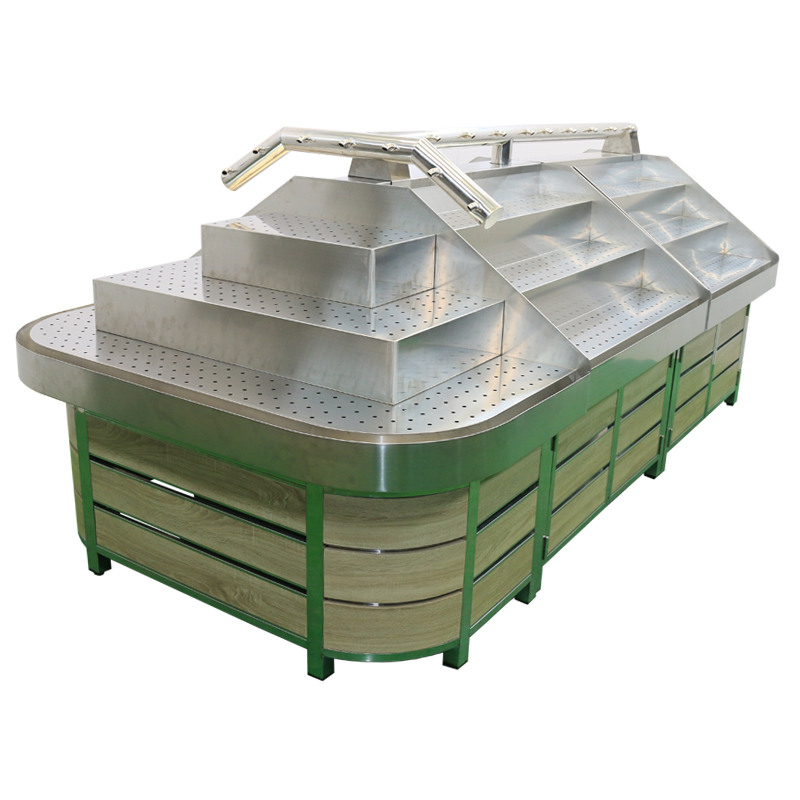
-
 National service hotline
National service hotline
- 400-082-1188
- What is the most important thing at the cash register of the convenience store
- What is the practicability of fresh food shelf
- What should be paid attention to when displaying goods on shelves in the bulk weighing area
- What are the applications of Zhongdao double-sided shelves in supermarkets
- What are the characteristics of steel and wood shelves
What are the structural design characteristics of the shelves in the fresh food area
source:www.juren.top | Release time:2025年02月18日1. Multi layer and multi-faceted display: Multi layer structures are usually used to increase display space and fully showcase various fresh products. At the same time, some shelves will be designed as multi sided displays, such as double-sided or four sided shelves, to facilitate customers to select products from different directions, improve product exposure and accessibility.
2. Open design: The shelves in the fresh food area are mostly open structures without closed cabinet doors or partitions, allowing customers to directly access and select products, increasing the intuitiveness and participation of shopping. This design is also beneficial for maintaining ventilation of fresh products and preventing them from spoiling due to stuffiness.
3. Clear zoning: Clear zoning is carried out based on the types of fresh products, such as vegetable and fruit areas, meat areas, seafood areas, cooked food areas, etc. The shelf structure and configuration in each area will vary to accommodate the characteristics of different products. For example, the shelves in the vegetable and fruit area may have sloping shelves to facilitate the natural rolling display of fruits and vegetables; The shelves in the meat area may be equipped with refrigeration devices to maintain the freshness of the meat.
4. Strong load-bearing capacity: Due to the heavy weight of fresh products such as fruits, vegetables, meat, seafood, etc., shelves need to have strong load-bearing capacity. The material of the shelves is generally made of sturdy steel or good plastic, and the design of the shelves and frames is also strengthened to ensure that they can withstand the weight of a large number of goods and are not easily deformed or damaged.
5. Easy to clean and maintain: Fresh products are prone to produce juice, stains, etc. In order to maintain the cleanliness and hygiene of the shelves, the structural design of the shelves in the fresh area is easy to clean and maintain. The surface of the shelf is usually smooth and flat, without dead corners, and is not easy to accumulate dirt; The components such as shelves and partitions can be disassembled for easy cleaning and disinfection; Some shelves are also designed with drainage systems to promptly drain the moisture generated by the goods.
6. Reasonable lighting design: Reasonable lighting design is very important for highlighting the color and texture of fresh products. Fresh food shelves are usually equipped with specialized lighting fixtures, such as LED spotlights or light strips, to enhance the display effect of products. The color and brightness of the lighting are also carefully selected, usually using warm toned lighting to make fresh products look fresher and more tempting.
7. Temperature control facilities: For fresh products that require refrigeration or freezing, shelves will be equipped with corresponding temperature control facilities, such as refrigerators, freezers, etc. These facilities are closely integrated with the shelf structure to form an integrated display and storage system, ensuring that goods are stored at suitable temperatures and extending shelf life.
8. Anti slip design: In order to prevent fresh products from rolling or slipping on the shelves, the shelves and display surfaces will adopt anti slip design. For example, adding anti slip pads or textures on the surface of the laminated board to increase friction and ensure stable placement of the product on the shelf.
9. Adjustable: The height and spacing of the shelves in the fresh food area are usually adjustable to meet the display needs of different sizes and shapes of goods. This adjustability enables shelves to flexibly adapt to changes in product types and seasonal adjustments, improving shelf efficiency.
Prev:
What are the characteristics of a convenience sto…
Next:
How to choose a convenience store checkout counter

 Micro signal:
Micro signal:


 official account
official account
 applet
applet
 wechat
wechat
 contact
contact
 phone
phone